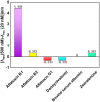Humanoid-shaped WaveFlex biosensor for the detection of food contamination
- PMID: 37791266
- PMCID: PMC10545203
- DOI: 10.1364/BOE.500311
Humanoid-shaped WaveFlex biosensor for the detection of food contamination
Abstract
High-toxicity secondary metabolites called aflatoxin are naturally produced by the fungus Aspergillus. In a warm, humid climate, Aspergillus growth can be considerably accelerated. The most dangerous chemical among all aflatoxins is aflatoxin B1 (AFB1), which has the potential to cause cancer and several other health risks. As a result, food forensicists now urgently need a method that is more precise, quick, and practical for aflatoxin testing. The current study focuses on the development of a highly sensitive, specific, label-free, and rapid detection method for AFB1 using a novel humanoid-shaped fiber optic WaveFlex biosensor (refers to a plasmon wave-based fiber biosensor). The fiber probe has been functionalized with nanomaterials (gold nanoparticles, graphene oxide and multiwalled carbon nanotubes) and anti-AFB1 antibodies to enhance the sensitivity and specificity of the developed sensor. The findings demonstrate that the developed sensor exhibits a remarkable low detection limit of 34.5 nM and exceptional specificity towards AFB1. Furthermore, the sensor demonstrated exceptional characteristics such as high stability, selectivity, reproducibility, and reusability. These essential factors highlight the significant potential of the proposed WaveFlex biosensor for the accurate detection of AFB1 in diverse agricultural and food samples.
© 2023 Optica Publishing Group under the terms of the Optica Open Access Publishing Agreement.
Conflict of interest statement
The authors declare that they have no known competing for financial interests or personal relationships that could have appeared to influence the work reported in this paper. The authors declare no conflicts of interest.
Figures












References
-
- Joseph Owuor L., Solomon O., Dora A. O. O., “Aflatoxin B1: Chemistry, Environmental and Diet Sources and Potential Exposure in Human in Kenya,” in Aflatoxin B1 Occurrence, Detection and Toxicological Effects , Xi-Dai L., ed. (IntechOpen, Rijeka, 2019), Chap. 1.
-
- Pal T., Aditya S., Mathai T., Mukherji S., “Polyaniline coated plastic optic fiber biosensor for detection of aflatoxin B1 in nut, cereals, beverages, and body fluids,” Sens. Actuators, B 389, 133897 (2023). 10.1016/j.snb.2023.133897 - DOI
-
- Bartolić D., Mutavdžić D., Carstensen J. M., Stanković S., Nikolić M., Krstović S., Radotić K., “Fluorescence spectroscopy and multispectral imaging for fingerprinting of aflatoxin-B1 contaminated (Zea mays L.) seeds: a preliminary study,” Sci. Rep. 12(1), 4849 (2022). 10.1038/s41598-022-08352-4 - DOI - PMC - PubMed
LinkOut - more resources
Full Text Sources
Research Materials
